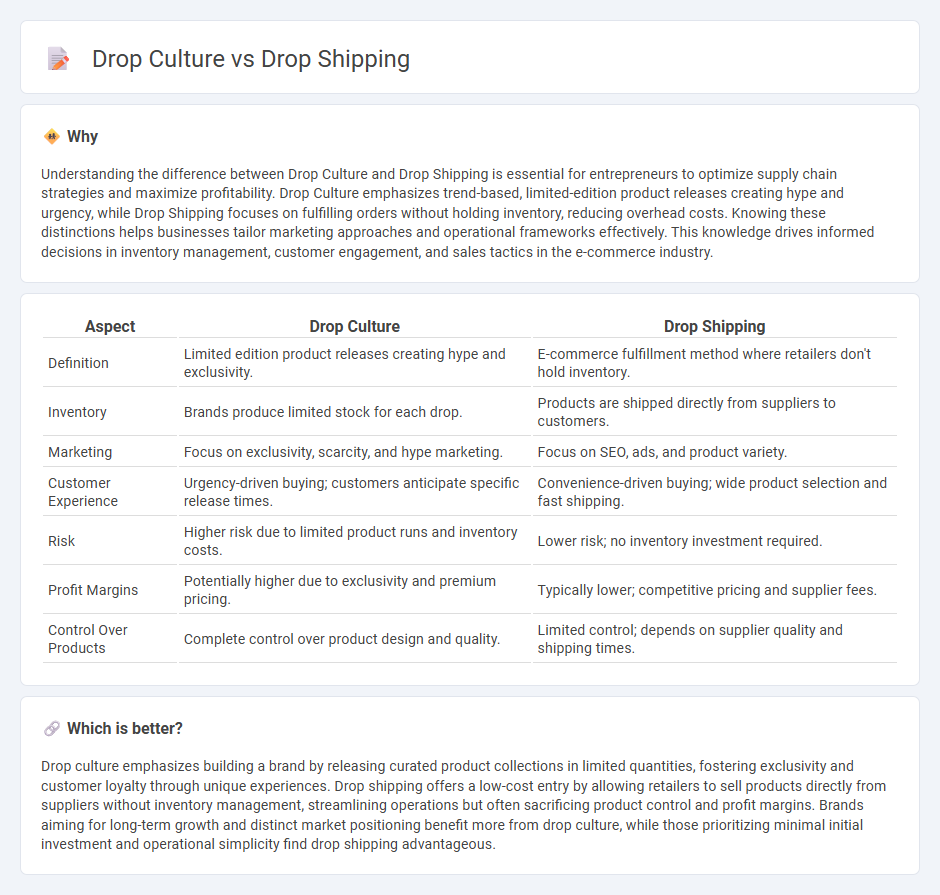
Drop culture emphasizes limited-edition product releases that create scarcity and hype among consumers, driving demand through exclusivity and brand loyalty. Drop shipping, on the other hand, is an e-commerce fulfillment method where sellers transfer customer orders directly to suppliers without holding inventory, enabling low overhead costs and flexible product offerings. Explore the differences between drop culture and drop shipping to optimize your commerce strategy.
Why it is important
Understanding the difference between Drop Culture and Drop Shipping is essential for entrepreneurs to optimize supply chain strategies and maximize profitability. Drop Culture emphasizes trend-based, limited-edition product releases creating hype and urgency, while Drop Shipping focuses on fulfilling orders without holding inventory, reducing overhead costs. Knowing these distinctions helps businesses tailor marketing approaches and operational frameworks effectively. This knowledge drives informed decisions in inventory management, customer engagement, and sales tactics in the e-commerce industry.
Comparison Table
| Aspect | Drop Culture | Drop Shipping |
|---|---|---|
| Definition | Limited edition product releases creating hype and exclusivity. | E-commerce fulfillment method where retailers don't hold inventory. |
| Inventory | Brands produce limited stock for each drop. | Products are shipped directly from suppliers to customers. |
| Marketing | Focus on exclusivity, scarcity, and hype marketing. | Focus on SEO, ads, and product variety. |
| Customer Experience | Urgency-driven buying; customers anticipate specific release times. | Convenience-driven buying; wide product selection and fast shipping. |
| Risk | Higher risk due to limited product runs and inventory costs. | Lower risk; no inventory investment required. |
| Profit Margins | Potentially higher due to exclusivity and premium pricing. | Typically lower; competitive pricing and supplier fees. |
| Control Over Products | Complete control over product design and quality. | Limited control; depends on supplier quality and shipping times. |
Which is better?
Drop culture emphasizes building a brand by releasing curated product collections in limited quantities, fostering exclusivity and customer loyalty through unique experiences. Drop shipping offers a low-cost entry by allowing retailers to sell products directly from suppliers without inventory management, streamlining operations but often sacrificing product control and profit margins. Brands aiming for long-term growth and distinct market positioning benefit more from drop culture, while those prioritizing minimal initial investment and operational simplicity find drop shipping advantageous.
Connection
Drop culture and drop shipping are connected through their shared emphasis on limited-edition product releases and streamlined fulfillment processes that capitalize on consumer demand. Drop culture drives exclusivity and urgency by promoting time-sensitive or quantity-limited product launches, which drop shipping facilitates by eliminating inventory holding and enabling fast, direct-to-consumer delivery. This synergy allows businesses to reduce overhead costs while leveraging hype marketing to maximize sales in e-commerce.
Key Terms
Inventory Management
Drop shipping eliminates the need for inventory management by directly shipping products from suppliers to customers, reducing overhead costs and storage requirements. In contrast, drop culture emphasizes curating limited-edition product releases, requiring precise inventory control to meet consumer demand without overstocking. Explore the nuances of inventory strategies in both models to optimize supply chain efficiency.
Hype/Scarcity
Drop shipping leverages product scarcity by limiting stock availability, creating a perception of exclusivity and urgency among consumers to boost sales. In contrast, drop culture embodies hype generated through carefully timed releases of limited-edition items, often fueled by social media buzz and influencer endorsements, heightening demand through exclusivity and anticipation. Explore deeper insights into how hype and scarcity drive consumer behavior in these dynamic retail strategies.
Supply Chain
Drop shipping eliminates inventory holding by directly shipping products from suppliers to customers, optimizing supply chain efficiency and reducing storage costs. Drop culture emphasizes limited-time product releases to create demand urgency, requiring agile supply chain coordination for timely stock availability. Explore the nuances of supply chain strategies in drop shipping and drop culture to enhance your business model.
Source and External Links
Drop shipping - Wikipedia - Drop shipping is a retail business model where the seller accepts customer orders without keeping stock on hand and instead forwards orders to a manufacturer, wholesaler, or fulfillment house who ships directly to the customer.
What Is Dropshipping and How Does It Work? (2025) - Shopify - Dropshipping works by partnering with a dropshipping supplier who stores and ships products, while the seller sets up an online store, receives customer orders, and forwards them to the supplier for fulfillment.
What Is Dropshipping and How Does It Work? - Wix Blog - Dropshipping is a retail fulfillment method where the retailer sells products without stocking inventory, purchasing them only from a third party after customer orders are made, who then ships directly to the consumer.
 dowidth.com
dowidth.com